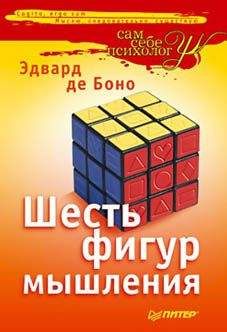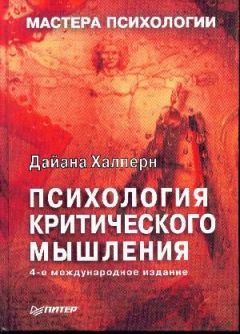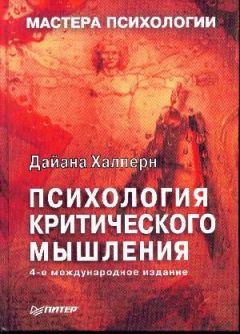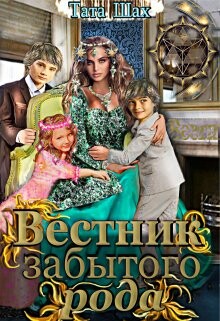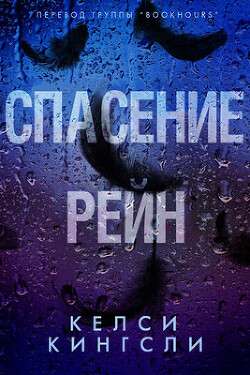Дайана Халперн - Психология критического мышления

Помощь проекту
Психология критического мышления читать книгу онлайн
Allegretti C. L, Frederick J. N. (1995). A model for thinking critically about ethical issues. In D. F. Halpern S. G. Nummedal (Eds.), Psychologists teach critical thinking [Special issue]. Teaching of Psychology, 22,46–18.
Allport G. W. (1954). The nature a/prejudice. Cambridge, MA: Addison-Wesley
Amabile 7 M. (1983). The social psychology of creativity. New York: Springer-Verlag.
Amabile Т. М. (1989). Crowing up creative: Nurturing a lifetime of creativity. New York: Crown.
American Association of Medical Colleges. (1984). Report of the working group on fundamental skills. Journal of Medical Education, 59, 1.
American Psychiatric Association. (1994). Diagnostic and statistical manual of mental disorders (4th ed.).Washington, DC: Author.
American Psychological Association. (1992). Learner-centered psychological principles: Guidelines for school redesign and reform [Draft]. The Psychology Teacher Network, 2, 5-12.
Anderson B. F. (1980). The complete thinker. A handbook of techniques for creative and critical problem solving. Englewood Cliffs, NJ: Prentice-Hall.
Arasteh A. R., Arasteh J. D. (1976). Creativity in human development. New York: Schenkman.
Arkes H. R., Hammond, K. R. (Eds.). (1986a). Judgment and decision making: An interdisciplinary reader. Cambridge, MA: Cambridge University Press.
Arkes H. R., Hammond, K. R. (1986b). Law. In H. R.
Arkes K. R. Hammond (Eds.), judgment and decision making: An interdisciplinary reader (pp. 211–212). Cambridge, MA: Cambridge University Press. Arnheim R. (1971). Visual thinking. Berkeley: University of California Press. Asimov 1. (1989, March 31). Combating US scientific illiteracy. Los Angeles Times, Part V, p. 8. Atkinson R. С (1975). Mnernotechnics in second-language learning. American Psychologist, 30, 821–828.
Baddeley A. D. (1986). Working memory. London: Oxford University Press.
Baddeley A. D. (1992). Working memory. Science, 255, 556–559.
Baer J. (1993). Creativity and divergent thinking. Hills-dale, NJ: Lawrence Erlbaum Associates.
Bailin S. (1987). Creativity and skill. In D. N. Perkins, J. Lochhead, J. Bishop (Eds.), Thinking: The second international conference (pp. 323–332). Hills-dale, NJ: Lawrence Erlbaum Associates. Baron J. (1987). An hypothesis about the training of intelligence. In D. N. Perkins, J. Lochhead, J. Bishop (Eds.), Thinking: The second internal conference (pp. 60–67). Hillsdale, NJ: Lawrence Erlbaum Associates. Baron J. (1988). Thinking and deciding. New York: Cambridge University Press.
Baron J. (1990). Harmful heuristics and the improvement of thinking. In D. Kuhn (Ed.). Developmental perspectives on teaching and learning thinking skills (pp. 28–47). New York. Basel, Karger. Baron. J., Brown. R. V. (Eds.). (1991). Teaching decision making to adolescents. Hillsdale, NJ: Lawrence Erlbaum Associates.
Baron J. В., Sternberg R. J. (Eds.) (1987). Teaching thinking skills: Theory and practice. New York Freeman.
Barron, F. (1958). The psychology of imagination. Scientific American, 199,151–166. Bartlett F. С (1932). Remembering: A study In experimental and social psychology. Cambridge, England: Cambridge University Press. Bartlett J. (1980). Familiar quotations (15th and 125th anniversary eds.). Boston: Little, Brown. Bartlett J. (1992) Familiar quotations. (17th ed.). Boston: Little, Brown.
Bauer M. /., Johnson-Laird P. N. (1993). How diagrams can improve reasoning. Psychological Science, 4, 372–378.
Begley S. (1993, June 28). The puzzle of genius. Newsweek, pp. 46–49.
Beilensen J., Jackson H. (Eds.). (1992). Voices of struggle, voices of pride. White Plains. NY: Peter Pauper Press, Inc. Bell R., Caplans, J. (1976). Decisions, decisions: Game
theory and you. New York; Norton. BergerD. (1994). Critical thinking. Paper presented at Loma Linda Medical Center. Available from author at Claremont Graduate School, Claremont, CA. Berger, D. (1995). Errors in judgments and decisions: Understanding our cognitive fallibilities. In P. Foster (Ed.), Critical Thinking: Views and values in college teaching (pp. 48–68). Riverside, CA: La Sierra University Press.
Berkowitz L., Thome P. R. (1987). Pain expectation, negative affect, and angry aggression. Motivation and Emotion, 11, 183–193.
Berlin В., Kay P. (1969). Basic color terms: Their universality and evolution. Berkeley: University of California Press.
Berliner И. J. (1977). Some necessary conditions for a master chess program. In P. N. Johnson-Laird P. С. Wason (Eds.), Thinking: Readings in cognitive science. Cambridge, England: Cambridge University Press.
Bernstein D. A. (1995). A negotiation model for teaching critical thinking. In D. F. Halpern S. G. Nummedal (Eds.), Psychologists teach critical thinking. [Special Issue]. Teaching of Psychology, 22, 22–24.
Beyth-Marom R, Dekel S., Gombo R., Shaked M. (1985). An elementary approach to thinking under uncertainty. Hillsdale, NJ: Lawrence Erlbaum Associates.
Block RA. (1985). Education and thinking skills reconsidered. American Psychologist, 40, 574–575.
Bloom B. S., Broder, L. J. (1950). Problem solving processes of college students. Chicago: The University of Chicago Press.
Boden M. A. (1990). The creative mind: Myths mechanisms. New York: Basic Books.
Boring E. G. (1932). Intelligence as the tests test it. New Republic, 35, 35–37.
Bousfield, W. A. (1953) The occurrence of clustering in the recall of randomly arranged associates. Journal of General Psychology. 49, 229–240.
Bower G. H. (1970). Organizational factors in memory. Cognitive Psychology, 1, 18–46.
Bower G. H. (1972). Mental imagery and associative learning. In L. Gregg (Ed.), Cognition in learning and memory. New York; Wiley.
Bower G. (1994, May 25). Electronic communication from Marina Volkov at the Federation of Behavioral, Psychological, and Cognitive Sciences, [email protected]
Bower G. H., Cirilo R. K. (1985). Cognitive psychology and text processing. In Handbook of Discourse Analysis, (Vol. 1, pp. 71-105). New York: Academic Press.
Bower G. H., Clapper, J. P. (1989). Experimental methods in cognitive science. In M. I. Posner (Ed.), Foundations of cognitive science (pp. 245–301). Cambridge, MA MIT Press.
Bower G. H., Clark M. C. (1969). Narrative stones as mediators for serial learning. Psychonomic Science, 14,181–182.
Boxall B. (1993, October 12). Statistics and science can be twisted to suit debate. The Los Angeles Times, p. A18.
Bozzell L В., III. (1993, July 21). Exposing statistical myths. The Washington Times, p. 64.
Bradbury R. (1950). Fahrenheit 451. New York: Simon Schuster.
Braine M. D. S. (1978). On the relation between the natural logic-of reasoning and standard logic. Psychological Review, 85,1-21.
Brans ford D. (1979). Human cognition: Learning, understanding and remembering. Belmont, CA: Wad-sworth.
Bransford J. D., Arbitman-Smith /?., Stein, B. S., Vye N.J. (1985). Improving thinking and learning skills: An analysis of three approaches. In J. W. Segal S. F. Chipman (Eds.), Thinking and learning skills:
Volume 1. Relating instruction to research (pp. 133–206). Hillsdale, NJ: Lawrence Erlbaum Associates.
Bransford J. D., Johnson M. K. (1972). Contextual prerequisites for understanding: Some investigations of comprehension and recall. Journal of Verbal learning and Verbal Behavior, 11, 717–726.
Bransford J. D., Sherwood /?., Vye N., RieserJ. (1986). Teaching thinking and problem solving: Research foundations. American Psychologist, 41, 1078–1089.
Bransford J. D., Stein B. S. (1993). The ideal problem solver: A guide for improving thinking, learning, and creativity (2nd ed.). New York: Freeman.
Brehm J. W. (1956). Postdecision changes in the desirability of alternatives. Journal of Abnormal and Social Psychology, 52, 384–389.
Brennan J. (1993b. May 20). Why polls can be poles apart. The Los Angeles Times, p. A5.
Brim 0. G., Jr. (1966). High and low self-estimates of intelligence. In 0. G.
Brim Jr., R. S. Crutchfield, W. H. Holtzman (Eds.), Intelligence: Perspectives 1965. New York: Har-court, Brace World.
Brody J. E. (1988, March 30). Unresolved relationship: Breast cancer, dietary fat. San Francisco Chronicle, pp. 2–3.
Brooks L W., Simutis Z. M., O'Neil H. F., Jr. (1985). The role of individual differences in learning strategies research. In R. F. Dillon (Ed.l, Individual differences in cognition (Vol. 2, pp. 219–251). New York: Academic Press.
Bross I. D. J. (1973). Languages in cancer research. In G. F. Murphy, D. Pressman, E. A. Mirand (Eds.), Perspectives in cancer research and treatment (pp. 213–221), New York: Alan R. Liss.
Brown R. (1958). Words and things. New York: The Free Press.
Brown A. L., Campione J. C. (1990). Communities of learning and thinking or a context by any other name. In D. Kuhn (Ed.), Developmental perspectives on teaching and learning thinking skills. Contributions to human development (Vol. 21, pp. 108–126). Basel Switzerland: Karger.
Brown S., Walter M. (1993). Problem posing: Reflections and applications. Hillsdale, NJ: Lawrence Erlbaum Associates.
Bruer J. T. (1993). Schools for thought. Cambridge, MA: MTT Press.
Brunei J. S. (1957). On going beyond the information given. In Contemporary approaches to cognition (pp. 41–69). Cambridge, MA: Harvard University Press.
Bruner J. S.t Goodnow J. J., Austin G. A. (1956). A study of thinking. New York: Wiley.
Bugllosi V. (1978). Till death do us part. New York: Bantam Books.
Burke D. M., MacKay D. G., Worthley J. S., Wade E. (1991). On the tip of the tongue: What causes word finding failures in young and older adults? Journal of Memory and Language, 30, 542–579.
Byrne R. (1988). One thousand nine hundred eleven best things anybody ever said. New York: Fawcett.
CampbellS. K. (1974). Flaws and fallacies in statistical
thinking. Englewood Cliffs, NJ: Prentice.Hall. Carey J., Foltz K., Allan /?. A. (1983, February 7). The
mind of the machine. Newsweek. Carkhuff R. R. (1973). The art of problem solving. Amherst, MA: Human Resource Development Press. Carlson E. (1995). Evaluating the credibility of sources: A missing link in the teaching of critical thinking. In D. F. Halpern S. G. Nummedal (Eds.), Psychologists teach critical thinking[Special issue). Teaching of Psychology, 22, 39–41. Carpenter E. J. (1981). Piagetian interviews of college students. In R. G. Fuller et al. (Eds.), Piagetian programs in higher education (pp. 15–22). Lincoln: University of Nebraska Press. Carroll D. W. (1986). Psychology of language. Belmont, CA: Brooks/Cole.
Carroll L. (1971). Through the looking glass. London: Oxford University Press. (Original work published 1872)
Cassel J. F., Congleton R. I. (1993). Critical thinking: An annotated bibliography. Metuchen, NJ: Scarecrow Press.
Ceci S. J., Ruiz A. I. (1993). Inserting context into our thinking about thinking: Implications for a theory of everyday intelligent behavior. In M. Rabinowitz (Ed.). Cognitive science foundations of instruction (pp. 173–188). Hillsdale, NJ: Lawrence Erlbaum Associates.
Ceraso J., Protivera A. (1971). Sources of error in syllogistic reasoning. Cognitive Psychology, 2, 400–416.
Champagne A. B. (1992). Cognitive research on thinking in academic science and mathematics: Implications for practice and policy. In D. F. Halpern (Ed.), Enhancing thinking skills in the sciences and mathematics (pp. 117–134). Hillsdale, NJ: Lawrence Erlbaum Associates. Chance P. (1986). Thinking in the classroom: A survey of programs. New York: Teachers College Press.
Chang J. (1993). Wild swans: Three daughters of China. New York: HarperCollins.
Chapman L. J., Chapman J. P. (1959). Atmosphere effect reexamined. Journal of Experimental Psychology, 58, 220–226.
Chapman L. /., Chapman J. P. (1967). The genesis of popular but erroneous psychodiagnostic observations. Journal of Abnormal Psychology, 72, 193–204.
Chapman L. J., Chapman J. F. (1969). Illusory correlation as an obstacle to the use of valid psychodiagnostic signs. Journal of Abnormal Psychology, 74, 271–280.
Cheng P. W., Holyoak K. J. (1985). Pragmatic reasoning schemas. Cognitive Psychology, 17, 391–416. Chester P. (1972). Women and madness. New York: Doubleday.
ChiM. T. H., GlaserR., Farr. M. J. (Eds.). (1988). The nature of expertise. Hillsdale, NJ: Lawrence Erlbaum Associates.
Cialdini R. В. (1993). Influence: Science and practice (3rd ed.). Glenview, IL: Scott, Foresman.
Clark H. H., Clark E. V. (1977). Psychology and language: An introduction to psycholinguistics. New York: Harcourt Brace.
Clark H. H., Haviland S. E. (1977). Comprehension and the given-new contract. In R. 0. Freedle (Ed.), Discourse production and comprehension. Norwood, NJ: Ablex.
